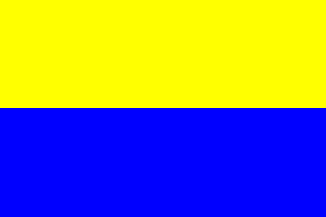![[Epe new flag]](../images/n/nl-ge_ep.gif) image located by Valentin Poposki, 21 November 2025
image located by Valentin Poposki, 21 November 2025used since January 2003

Last modified: 2025-11-29 by rob raeside
Keywords: epe |
Links: FOTW homepage |
search |
disclaimer and copyright |
write us |
mirrors
![[Epe new flag]](../images/n/nl-ge_ep.gif) image located by Valentin Poposki, 21 November 2025
image located by Valentin Poposki, 21 November 2025
used since January 2003
External site:
Until Jan 2003 the municipality of Epe, Gelderland province, had an
unofficial flag with in the canton the municipal arms.
Mello Luchtenberg just sent me the new flag of Epe: white with the
municipal logo. So there is even progress in the Veluwe region!
Jarig Bakker, 14 November 2004
 image located by Valentin Poposki, 21 November 2025
image located by Valentin Poposki, 21 November 2025The flag of Epe is an unofficial flag based
on the municipal flag used during the parade in Amsterdam in honor of Queen
Wilhelmina's 40th anniversary in 1938, but to date, it has not yet been adopted
by the Epe municipal council as the municipal flag. The municipality of Epe has
not adopted an official municipal flag, but the municipal council does use an
unofficial white flag bearing the municipal logo, which is used exclusively by
the municipal council and is not registered in the flag register.
https://nl.wikipedia.org/wiki/Vlag_van_Epe
Valentin Poposki, 21 November 2025
 Shipmate Flagchart : http://www.flagchart.net
Shipmate Flagchart : http://www.flagchart.net
![[Epe Coat of Arms]](../images/n/nl-ge)ep.gif) image located by Valentin Poposki, 21 November 2025
image located by Valentin Poposki, 21 November 2025Description: Azure a deer standing on a base, surrounded by a wreath
of oakleaves, all or.
Epe had already a seal like that in 1465; it belonged to the parish
of Epe, with a deer. This has been found on a parchment charter of 1465,
in which Henrick opten Brynck, Aernt Dorre and Frederik van Oerle, churchwardens
of Epe, declared that they sold a "tyns" (tax) to the St. Agnieten
monastery in Elburg. That was an amount of one and a half "groot"
(Dutch groat - one halfpenny) per year out of farms in Oosterwolde. The
churchwardens attached a seal of the parish of Epe, which stayed intact
until now. On this seal is a "royal deer", a "tienender" (with antlers
with 10 horns), surmounted by an escutcheon
with the arms of the former Counts of Gelre.
In the arms of Harderwijk that can still be seen: a lion with billets.
The 1465 seal is the only one known. Perhaps it existed already before
1400, judging by the style of the ornaments.
In 1795 the French changed the former "richterambten" (old municipal
dividions) into "municipaliteiten", which adopted arms and seals.
While several municipalities chose new freedom-symbols (a maiden, a tree),
Epe decided to reintroduce Mr. Deer.
Source: The Epe municipal website.
Jarig Bakker, 14 Nov 2004
![[Emst village flag]](../images/n/nl-ge_em.gif) by Jarig Bakker, 30 Sep 2004
by Jarig Bakker, 30 Sep 2004
Emst is a village in the Veluwe region, municipality Epe, Gelderland
province.
Its flag was chosen after a design competition in 2000.
The circular form symbolizes the central position of Emst in Epe municipality.
The wooden hay-shed represents the countryside.
The general division in four rectangles is for the four villages in
the municipality: Epe, Oene, Emst & Vaassen
Green symbolizes the green Veluwe area.
Brown is for the wooded area.
Yellow is for the Veluwe sand, grain and sunny aspects of life in general
and in Emst in particular
Blue is for water in brooks, channels, watercourses, pools.
Design: Mr. Vijge.
Source: Emst village
website, spotted by Mr. Marcel van Westerhoven.
Note: a hay-shed consisted of four large poles, which sustained a pyramid-shaped
wooden roof, which could be lowered and lifted depending of the amount
of hay in the shed. Its secondary significance was that one could judge
the wealth of the farmer by the hay left in hard times. Suitors passed
the sheds where there was no hay visible...
Jarig Bakker, 30 Sep 2004